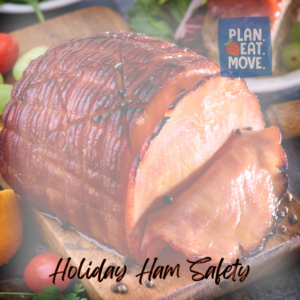Ham is available in many variations which makes it a popular meat to serve at holiday gatherings. If you are in the market to purchase a ham, you might see terms such as fresh, canned, cook before eating, fully cooked, smoked, and country written on the package. With all of these terms, it can be unclear how best to choose and prepare a ham that is safe, delicious, and something your family will enjoy.

Fresh ham is an uncured leg of pork. Fresh ham is similar in flavor and appearance to fresh pork loin. Fresh ham must always be cooked.
Cured ham is the addition of salt, sodium or potassium nitrate, sugars, flavorings, and other additives to the meat. Curing is used for preservation, tenderization, and color and flavor enhancement. Cured hams are usually pink in color.
Fresh and cured hams can be purchased smoked. This process allows the ham to absorb the smokiness from smoldering fires. This adds additional flavor and color to the meat. Smoked hams can come either cooked or cook-before-eating.
Fully cooked hams can be eaten cold, right out of the package. Fully cooked hams are available in whole or halves, or vacuumed packaged. Spiral-cut ham is an example of a cooked ham that is safe to eat cold. In fact, reheating spiral cut hams can cause the meat to dry out and the glaze to run off the meat, so if reheating be sure to cover with heavy aluminum foil.
If desired, all fully cooked hams can be heated to 140 degrees Fahrenheit before serving. As a guideline, use this table for approximate cooking times:
| Fully Cooked Hams | Weight | Approximate Cooking Time Per Pound |
| Whole Ham, Bone-In | 10 to 14 pounds | 15 to 18 minutes |
| Half Ham, Bone-In | 5 to 7 pounds | 18 to 24 minutes |
| Canned, Boneless | 3 to 10 pounds | 15 to 20 minutes |
| Vacuum Packed, Boneless | 6 to 12 pounds | 10 to 15 minutes |
| Spiral Ham | 7 to 9 pounds | 10 to 18 minutes |
Hams that must be cooked will bear noticeable cooking instructions and safe-handling instructions on the package. Cook-before-eating hams must be cooked to at least 145 degrees Fahrenheit as measured with a food thermometer. Allow the ham to rest at least three minutes before carving. For personal preference reasons, some consumers might choose to cook meat to higher temperatures. As a guideline, use this table for approximate cooking times:
| Cook-Before-Eating Hams | Weight | Approximate Cooking Time Per Pound |
| Whole Ham, Bone-In | 10 to 14 pounds | 18 to 20 minutes |
| Half Ham, Bone-In | 5 to 7 pounds | 22 to 25 minutes |
| Shank or Butt Portion, Bone-In | 3 to 4 pounds | 35 to 40 minutes |
| Whole Fresh Ham Leg, Bone-In | 12 to 16 pounds | 22 to 26 minutes |
| Half Fresh Ham Leg, Bone-In | 5 to 8 pounds | 35 to 40 minutes |
| Whole Fresh Ham Leg, Boneless | 10 to 14 pounds | 24 to 28 minutes |
Country hams can be soaked in water in the refrigerator for four to 12 hours or longer to reduce the salt content before cooking. Cook country hams by boiling 20 to 25 minutes per pound. Then, drain, glaze and brown in the oven at 400 degrees Fahrenheit for 15 minutes.
Hopefully, this information has carved up the facts on ham and made it easier to understand how to choose and prepare a type that is right for your family. For more information, contact your County Extension Office.